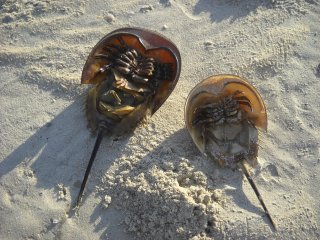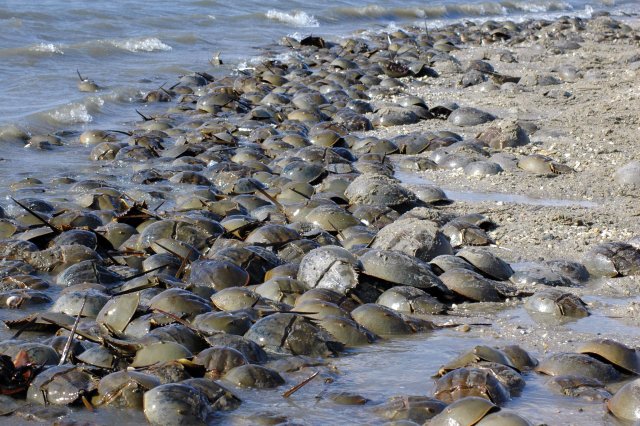Climate Change Connections: Delaware (Horseshoe Crabs)
Climate change is impacting all regions and sectors of the United States. The State and Regional Climate Change Connections resource highlights climate change connections to culturally, ecologically, or economically important features of each state and territory. The content on this page provides an illustrative example. As climate change will affect each state and territory in diverse ways, this resource only describes a small portion of these risks. For more comprehensive information about regional climate impacts, please visit the Fifth National Climate Assessment and Climate Change Impacts by Sector.
On this page:
Introduction: Horseshoe Crabs’ Cultural, Environmental, and Economic Importance

While strolling along the surf or scanning the tide pools, many Delaware beachgoers encounter horseshoe crabs. Horseshoe crabs evolved long before the dinosaurs, about 445 million years ago.1 They are sometimes referred to as “living fossils” because they have undergone very little evolutionary change.2 Horseshoe crabs are found along the Atlantic and Gulf Coasts of the United States. The Delaware Bay is the most critical breeding ground for horseshoe crabs.3 As a keystone species, they play a critical role in the estuary’s ecosystems. Horseshoe crabs host many species such as barnacles or mussels, and they also help control populations of sea floor-dwelling invertebrates such as sea anemones and sea urchins.4 Horseshoe crab eggs are an important food source for endangered and threatened shorebird species such as the red knot, as well as for many other species of migratory birds and turtles.4
Horseshoe crab blood, which is bright blue, is also highly valuable to certain industries due to its unique properties. Because horseshoe crab blood clots when it comes into contact with bacteria, pharmaceutical and biomedical companies use it in quality assurance tests for drugs, heart valves, insulin, vaccines, and more.2 To collect horseshoe crab blood, people harvest the crabs and transport them to a biomedical facility, where up to 40 percent of their blood volume can be extracted.2 After the crabs are bled, they are usually returned to the ocean; however, it is estimated that 10 percent to 30 percent of crabs do not survive the bleeding process.2

Every year between May and June, horseshoe crabs arrive by the thousands to Delaware beaches to spawn. While horseshoe crabs can be found up and down the Atlantic coast, the Delaware Bay hosts the largest concentration of spawning horseshoe crabs in the world.5 Horseshoe crabs crawl ashore to lay their eggs at high tide, usually during a full moon.
Climate Impacts: Sea Level Rise Threatens Horseshoe Crab Habitat
Although horseshoe crabs have survived numerous mass extinction events over millennia, new threats—including habitat loss, harvesting for use as bait and biomedical uses, and climate change—pose challenges for the species.6 Globally, warming temperatures are causing sea level to rise. The two key ways in which warming temperatures affect sea level is through the addition of water from melting land ice (glaciers and ice sheets) and the expansion of water itself due to warming ocean temperatures.7 Sea levels in Delaware are expected to rise anywhere from 1.6 to almost 5 feet by the end of the century, depending on greenhouse gas concentrations.8,9 Sea level rise can contribute to erosion, larger storm surges, increased severity of flooding from severe weather, and loss of critical shoreline habitat. Climate change-related sea level rise and beach erosion are predicted to threaten the horseshoe crabs’ critical spawning area.10
Delaware’s coast is experiencing more relative sea level rise than some other coastal regions because, while absolute sea levels are rising, the land is also sinking in a process known as subsidence.11,12 Relative sea level rise refers to how the height of the ocean rises or falls relative to the land at a particular location.6,11 Combined with coastal development, sea level rise also increases the likelihood of the shoreline shrinking between the water and infrastructure, leading to an overall reduction in horseshoe crab spawning habitat and the survival of larvae.6

Largely due to habitat loss and overharvesting, the American horseshoe crab is currently listed as vulnerable to extinction in the International Union for Conservation of Nature database.13 A further significant reduction in the horseshoe crab population could have consequences for the many species that rely on horseshoe crab larvae and eggs for food.5,14 Given the importance of horseshoe crab blood in pharmaceutical safety testing, population changes could affect the biomedical industry as well.
Taking Action: Protecting Living Fossils in a Changing Climate
Addressing climate change requires reducing greenhouse gas emissions while preparing for and protecting against current and future climate impacts. Communities, public officials, and individuals in every part of the United States can continue to explore and implement climate adaptation and mitigation measures. In Delaware, many stakeholders are collaborating on conservation measures that help protect horseshoe crabs in the face of multiple threats, including:
- Habitat protection. Nature-based coastal improvement projects known as “living shorelines” restore and strengthen wetland habitat to create a natural buffer against storms and sea level rise.15 Unlike hard structures like sea walls, living shorelines protect coastal infrastructure while also improving critical estuary ecosystems for species like horseshoe crabs.16 Closing beaches during spawning times can also protect horseshoe crab populations.
- Management of harvests. The Atlantic States Marine Fisheries Commission manages Atlantic horseshoe crab stock from Maine to eastern Florida to help prevent or reduce overfishing. Management actions include setting state-by-state quotas and catch limits for commercial and recreational harvesting.14 The Atlantic States Marine Fisheries Commission also monitors the population along the Atlantic coast to inform management decisions. Along with habitat protection and enhancement, continued monitoring and management of horseshoe crab populations are important steps to ensure the continued survival of these “living fossils.”
To learn more about climate change impacts in Delaware and the Northeast region, see Chapter 21 of the Fifth National Climate Assessment.
Related Resources
- EPA Climate Change Indicators: A Closer Look: Land Loss Along the Atlantic Coast
- EPA Climate Change Indicators: Sea Level
- Delaware State Climate Summary 2022 (NOAA)
- Delaware and Climate Change (Delaware Sea Grant)
References
1 Rudkin, D. M., & Young, G. A. (2009). Horseshoe crabs—An ancient ancestry revealed. In J. T. Tanacredi, M. L. Botton, & D. Smith (Eds.), Biology and Conservation of Horseshoe Crabs (pp. 25–44). Springer US. https://doi.org/10.1007/978-0-387-89959-6_2
2 Krisfalusi-Gannon, J., Ali, W., Dellinger, K., Robertson, L., Brady, T. E., Goddard, M. K. M., Tinker-Kulberg, R., Kepley, C. L., & Dellinger, A. L. (2018). The role of horseshoe crabs in the biomedical industry and recent trends impacting species sustainability. Frontiers in Marine Science, 5. https://www.frontiersin.org/articles/10.3389/fmars.2018.00185
3 NOAA Office for Coastal Management. (n.d.). Thirty years of horseshoe crab surveys reveal increase in species. Office for Coastal Management. Retrieved September 27, 2023, from https://coast.noaa.gov/states/stories/horseshoe-crab-surveys-reveal-increase-in-species.html
4 Botton, M. L. (2009). The ecological importance of horseshoe crabs in estuarine and coastal communities: A review and speculative summary. In J. T. Tanacredi, M. L. Botton, & D. Smith (Eds.), Biology and Conservation of Horseshoe Crabs (pp. 45–63). Springer US. https://doi.org/10.1007/978-0-387-89959-6_3
5 NOAA National Ocean Service. (2024). Are horseshoe crabs really crabs? National Ocean Service. Retrieved November 7, 2023, from https://oceanservice.noaa.gov/facts/horseshoe-crab.html
6 Smith, D. R., Brockmann, H. J., Beekey, M. A., King, T. L., Millard, M. J., & Zaldívar-Rae, J. (2017). Conservation status of the American horseshoe crab, (limulus polyphemus): A regional assessment. Reviews in Fish Biology and Fisheries, 27(1), 135–175. https://doi.org/10.1007/s11160-016-9461-y
7 Leung, L. R., Terando, A., Joseph, R., Tselioudis, G., Bruhwiler, L. M., Cook, B., Deser, C., Hall, A., Hamlington, B. D., Hoell, A., Hoffman, F. M., Klein, S., Naik, V., Pendergrass, A. G., Tebaldi, C., Ullrich, P. A., & Wehner, M. F. (2023). Ch. 3. Earth systems processes. In A. R. Crimmins, C. W. Avery, D. R. Easterling, K. E. Kunkel, B. C. Stewart, & T. K. Maycock (Eds.), Fifth National Climate Assessment. U.S. Global Change Research Program. https://doi.org/10.7930/NCA5.2023.CH3
8 Delaware Department of Natural Resources and Environmental Control. (n.d.). Sea level rise and Delaware’s wetlands. Watershed Stewardship. https://dnrec.alpha.delaware.gov/watershed-stewardship/wetlands/and-sea-level-rise/
9 Division of Energy and Climate. (2014). Delaware climate change impact assessment. Delaware Department of Natural Resources and Environmental Control. https://documents.dnrec.delaware.gov/energy/Documents/Climate%20Change%202013-2014/DCCIA%20interior_full_dated.pdf
10 NOAA Fisheries Office of Science and Technology. (n.d.). Horseshoe crab. National Oceanic and Atmospheric Administration. https://www.st.nmfs.noaa.gov/Assets/ecosystems/climate/images/species-results/pdfs/Horseshoe_Crab.pdf
11 EPA. (2023). Climate change indicators: Sea level [Reports and Assessments]. Retrieved December 4, 2023, from https://www.epa.gov/climate-indicators/climate-change-indicators-sea-level
12 Runkle, J., Kunkel, K. E., Easterling, D. R., Frankson, R., Champion, S. M., Stewart, B. C., Sweet, W., Leathers, D., DeGaetano, A. T., & Spaccio, J. (2022). Delaware state climate summary 2022 (NOAA Technical Report NESDIS 150-DE). NOAA National Environmental Satellite, Data, and Information Service. https://statesummaries.ncics.org/chapter/de/
13 Smith, D. R., Beekey, M. A., Brockmann, H. J., King, T. L., Millard, M. J., & Zaldívar-Rae, J. A. (2016). Limulus polyphemus, American horseshoe crab (The IUCN Red List of Threatened Species 2016). International Union for Conservation of Nature and Natural Resources. http://dx.doi.org/10.2305/IUCN.UK.2016-1.RLTS.T11987A80159830.en
14 ASMFC. (n.d.). Horseshoe crab. Retrieved September 27, 2023, from https://www.asmfc.org/species/horseshoe-crab
15 EPA. (2023). Coastal resiliency. Green Infrastructure. Retrieved December 22, 2023, from https://www.epa.gov/green-infrastructure/coastal-resiliency
16 NOAA. (n.d.). Living shorelines. NOAA Habitat Blueprint. Retrieved February 23, 2024, from https://www.habitatblueprint.noaa.gov/living-shorelines/

